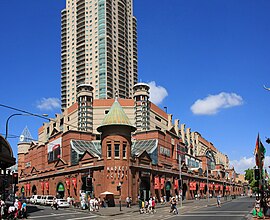Haymarket, New South Wales
|
Haymarket Sydney, New South Wales |
|||||||||||||
|---|---|---|---|---|---|---|---|---|---|---|---|---|---|

Sydney Market City building
|
|||||||||||||
| Population | 5,376 (2011 census) | ||||||||||||
| • Density | 13,400/km2 (35,000/sq mi) | ||||||||||||
| Postcode(s) | 2000 | ||||||||||||
| Area | 0.4 km2 (0.2 sq mi) | ||||||||||||
| LGA(s) | City of Sydney | ||||||||||||
| State electorate(s) | Sydney | ||||||||||||
| Federal Division(s) | Sydney | ||||||||||||
|
|||||||||||||
Haymarket is a suburb of Sydney, New South Wales, Australia. It is located at the southern end of the Sydney central business district in the local government area of the City of Sydney. Haymarket includes much of Sydney's Chinatown, Thaitown and Railway Square localities. Haymarket is adjacent to Darling Harbour and is surrounded by the suburbs of Ultimo, Chippendale, Surry Hills and the Sydney CBD.
Sydney's produce markets were located in Haymarket from the early 20th century through to the 1980s when they were moved to a new site at Flemington. Paddy's Markets still operate on part of the site of the vegetable markets as a produce and flea market. The 'Market City' complex contains the markets, The Peak apartment building, a modern shopping centre featuring a food court, restaurants, boutiques, specialty shops and entertainment options, such as a cinema and amusement centre.
The outer walls of the original vegetable market, built in 1909, were preserved and restored as an example of Edwardian architecture. They were part of the original city markets—designed by city architect C.Broderick—which were bounded by Hay Street, Quay Street and Thomas Street. They were built to replace the old Belmore Market, which had failed because it was too far from Darling Harbour.
...
Wikipedia
